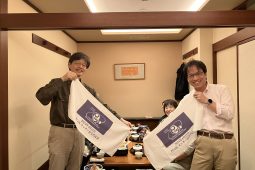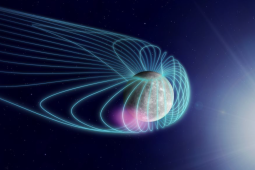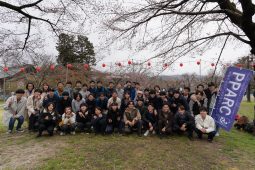PPARCセミナー(2023/10/27)

PPARCセミナー(2023/10/27)
(1)
[Name]
Shinnosuke Satoh
[Title]
Europa’s Interaction with the Jovian Magnetosphere: a Comprehensive Look through Both Models and Observations of Ultraviolet Auroras
[Abstract]
Europa, the moon orbiting at 9.4 Jupiter radii from the planet, is surrounded by the corotating plasmas in the Jovian magnetosphere that originate in both Europa and the neighboring satellite Io. The ions and electrons interact with Europa’s atmosphere and surface, inducing both physical and chemical changes in Europa’s environment by colliding with the atmospheric ions and neutrals and the surface components (e.g., Cassidy et al., 2013; Breer et al., 2019; Addison et al., 2022, 2023). The charged particles provide the external energy to Europa through collisions with the atmosphere and the surface. In this thesis, the following phenomena on Europa are investigated to better understand the electromagnetic interaction between the moon and the Jovian magnetosphere: (a) the brightness morphology of the oxygen 135.6 nm aurora in Europa’s atmosphere, and (b) Europa’s Alfvénic footprint aurora in Jupiter’s upper atmosphere.
(a) Observations with the Hubble Space Telescope showed that the brightness morphology of the oxygen 135.6 nm emissions on Europa’s atmosphere has a north-south asymmetry, which changes with Europa’s position relative to the Jovian magnetospheric plasma sheet (Roth et al., 2016). Similar north-south asymmetry of Io’s auroral limb glow has been explained by higher electron flux into the atmosphere on the hemisphere that faces the plasma sheet center (Retherford et al., 2003). This explanation, however, was not evaluated for the case of Europa quantitatively. We (Satoh et al., 2023) used a test particle simulation for the magnetospheric electrons and estimated the brightness morphology of the 135.6 nm emission in Europa. The systematically changing north-south asymmetry of Europa’s oxygen aurora has been successfully recreated by our model with a previously suggested idea, in which the strong deceleration of the magnetospheric flux tube results in the inhomogeneous electron flux into Europa’s atmosphere (the “slow-down effect”). With deceleration into 10% of the background plasma flow, the maximum north-to-south brightness ratio is estimated at 2.17 and 2.56 on the trailing and leading side, respectively. However, the previously observed brightness ratio is larger on the trailing side (up to 5). The results indicate that additional model scenarios are required to fully explain the north-south asymmetry of Europa’s oxygen aurora morphology.
(b) Electromagnetic interaction between Europa and the corotating plasma in the Jovian magnetosphere generates Alfvén waves, which leaves aurora footprints in Jupiter’s atmosphere. Equatorial lead angle, the angular separation between Europa and the position of the auroral footprint magnetically mapped onto the orbital plane, represents travel time of the Alfvén waves. We investigated FUV images of Jupiter obtained by the Hubble Space Telescope in 2014 and 2022 and found that the equatorial lead angle of the Europa footprint was larger in 2022, which indicates that the Alfvén travel time was longer in 2022. We developed a formula to retrieve the plasma conditions at Europa’s orbit from the lead angle by tracing the Alfvén propagation. Our retrieval shows for the first time that the changes in the ion density and ion core temperature at Europa’s orbit account for the variation of the footprint lead angle.
(2)
[Name]
Hiroyasu Kondo
[Title]
Statistical analysis of temporal variation and solar wind response of dawn-dusk asymmetry of Io-plasma torus using ultraviolet observations by HISAKI satellite and visible observations by Haleakala T60
[Abstract]
In Jupiter’s inner magnetosphere, there are regions with dense plasma from Io, forming the Io plasma torus (IPT). Slightly inside the Io orbit is a structure called “ribbon”, where Io-originated plasma spreads in the north-south direction along the magnetic field lines. It is known that ribbon’s positions are shifted dawnward due to the existence of the dawn-to-dusk electric field in the inner magnetosphere. Extreme ultraviolet (EUV) observations of IPT showed the electric field was enhanced under compressed conditions caused by the solar wind. However, there has been no report that the solar wind has influence on the ribbon’s radial position. Here we show the positive correlation between the temporal variation of the ribbon’s position and the solar wind. We analyzed the spatially resolved S[II] 6731 images observed by the Tohoku 60 cm Telescope (T60) at the top of Mt. Haleakala and the EUV emissions observed by the Hisaki satellite. We found that the ribbon’s position further moved dawnward when the solar wind enhanced, which indicates the enhancement of the dawn-to-dusk electric field due to the variation of the solar wind. From simultaneous observation with T60 and Hisaki on February 19–23, 2016, an averaged intensity of electric field derived from T60 is 3.9±0.81 mV/m, which is consistent with 2.8±1.2 mV/m from the Hisaki observation. We found for the first time that the dawnward shift was more significant on the dawn side rather than the dusk side. This implies the ionospheric conductivity is larger on the dawn side than on the dusk side. Our results demonstrate how the solar wind affects the nonuniformity of the electric field in the inner magnetosphere.





